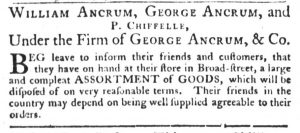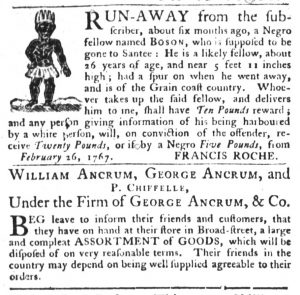Guest curating the Adverts 250 Project again was a very rewarding experience. I am always blown away by how much we can learn about a society or era by examining a few historical documents. Over the course of the project this semester I learned a lot of new things. One of my advertisements featured “West Indian Rum.” I was aware of the importance of the transatlantic trade to the American colonies, but I did not know how important rum was to local economies. Rum and molasses (a derivative of rum) were in great demand. Thus, businesses sprung up to buy rum and turn it into molasses; this helped support local communities. In addition, another advertisement I found was focused on equipment needed for whaling, including “whale boats” among other things. Before reading that advertisement I was, quite frankly, unaware that whaling was a lucrative trade in New England prior to the 1800s. I am always pleasantly surprised in the new information I gather from the research in this project. Even advertisements that I did not use for the project also expanded my knowledge of the colonial and revolutionary era. While browsing newspapers, advertisements placed by women stuck out to me, as they were fairly uncommon.
There were, of course, some challenges this time around. Some advertisements were much shorter in length, which made composing an analysis more challenging. Also choosing unique and diversified advertisements required a good amount of discernment and research skills. However, since it was my second time curating this project, there were some elements that were easier than my first curating experience. At this point, I was able to navigate the online newspaper databases in a much more efficient manner. Also, this time around I had a better idea of where to find my secondary sources. Last semester I relied heavily on one database. But this semester I drew articles from JSTOR, Colonial Williamsburg, and the New Bedford Whaling Museum. I also had the experience to know that economic journals sometimes yielded pertinent information even though they may not sound useful for a project focusing on colonial society. One such journal that I used for secondary articles was the Journal of Economic History. My prior experience with this project helped me improve the skills I needed as guest curator this semester.
As always, the very nature of this project taught me to really look at the past with an open mind and to overcome assumptions. Over the course of guest curating for this week, I have learned more about the whaling timeline in America and also challenged my ideas about currency and monetary transactions in the 1700s. This are important realizations which deepen my understanding of America’s history and how today’s society was built on the realities of colonial and Revolutionary America.
I would have to say that my favorite part of this project is sharing the end product with other students and scholars via the website. Instead of just handing in a paper to a professor or doing a presentation in class, I actually get to contribute to historical analysis in the real world, and not just my college classroom. Overall, my involvement with the Adverts 250 Project has granted me valuable insights into colonial and Revolutionary America. It has also granted me important experience working with online historical databases and secondary sources. I enjoyed my time working on the Adverts 250 Project. I wish all future good luck to all future guest curators.









